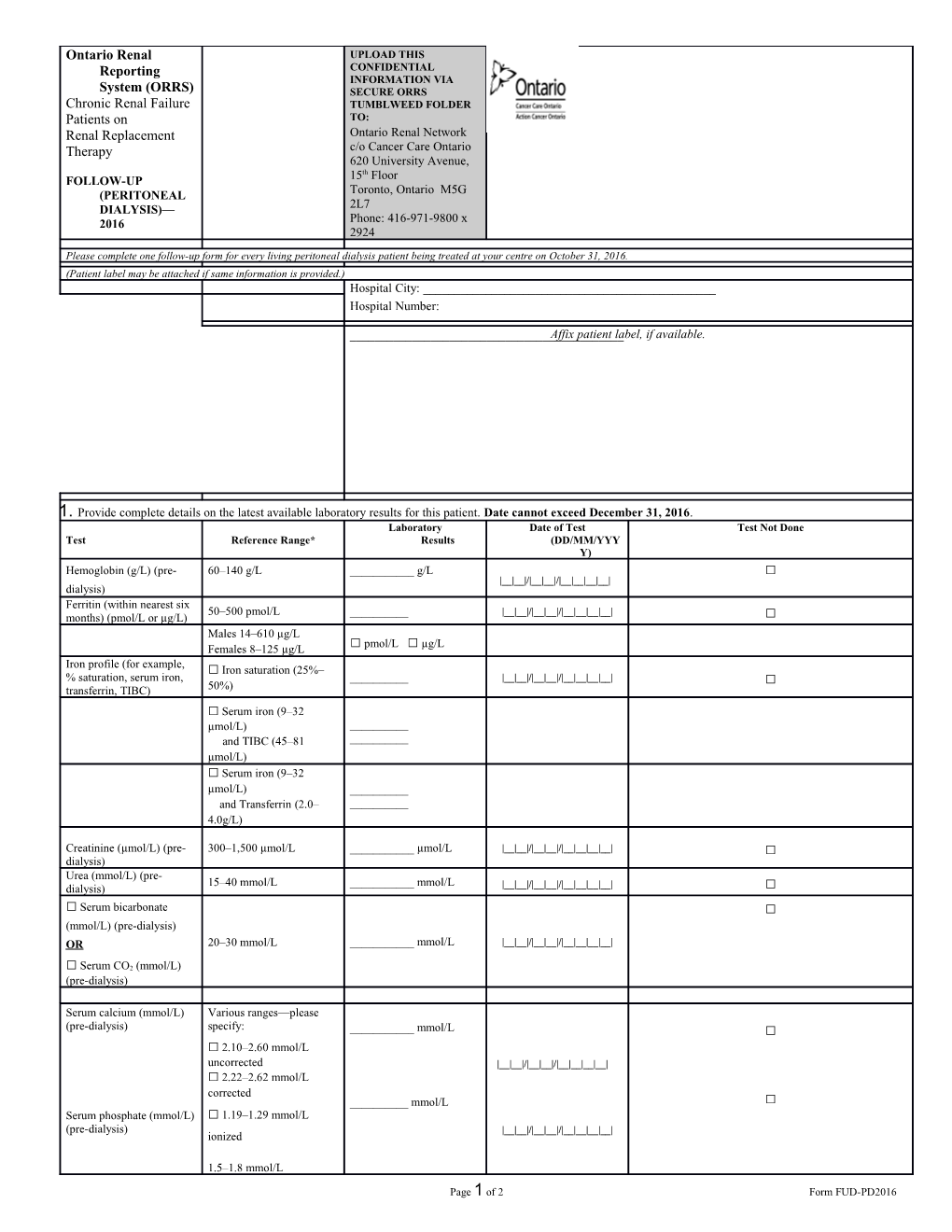Ontario Renal Reporting System (ORRS)
Chronic Renal Failure Patients onRenal Replacement Therapy
FOLLOW-UP (PERITONEAL DIALYSIS)—2016
/ UPLOAD THIS CONFIDENTIAL INFORMATION VIA SECURE ORRS TUMBLWEED FOLDER TO:Ontario Renal Network
c/o Cancer Care Ontario
620 University Avenue, 15th Floor
Toronto, Ontario M5G 2L7
Phone: 416-971-9800 x 2924 /
Please complete one follow-up form for every living peritoneal dialysis patient being treated at your centre on October 31, 2016.
(Patient label may be attached if same information is provided.)
Hospital Name: ______
Patient Last Name: ______
Patient First and Middle Names: ______
Current Health Card Number: ______
Province of Health Card: ______
Current Postal Code: |___|___|___| |___|___|___|
Date of Birth: |___|___|/|___|___|___|/|___|___|___|___|(DD/MON/YYYY) / Hospital City: ______
Hospital Number:
______
Affix patient label, if available.
- Provide complete details on the latest available laboratory results for this patient. Date cannot exceed December 31, 2016.
Test /
Reference Range*
/LaboratoryResults
/Date of Test(DD/MM/YYYY)
/Test Not Done
Hemoglobin (g/L) (pre-dialysis) / 60–140 g/L / ______g/L / |__|__|/|__|__|/|__|__|__|__| / □Ferritin (within nearest six months) (pmol/L or µg/L) / 50–500 pmol/L / ______/ |__|__|/|__|__|/|__|__|__|__| / □
Males 14–610 µg/L
Females 8–125 µg/L / □ pmol/L □ µg/L
Iron profile (for example, % saturation, serum iron,
transferrin, TIBC) / □Iron saturation (25%–50%) / ______/ |__|__|/|__|__|/|__|__|__|__| / □
□Serum iron (9–32 µmol/L)
and TIBC (45–81 µmol/L) / ______
______
□Serum iron (9–32 µmol/L)
and Transferrin (2.0–4.0g/L) / ______
______
Creatinine (µmol/L) (pre-dialysis) / 300–1,500 µmol/L / ______µmol/L / |__|__|/|__|__|/|__|__|__|__| / □
Urea (mmol/L) (pre-dialysis) / 15–40 mmol/L / ______mmol/L / |__|__|/|__|__|/|__|__|__|__| / □
□ Serum bicarbonate (mmol/L) (pre-dialysis) OR
□ Serum CO2 (mmol/L) (pre-dialysis) / 20–30 mmol/L / ______mmol/L / |__|__|/|__|__|/|__|__|__|__| / □
Serum calcium (mmol/L) (pre-dialysis)
Serum phosphate (mmol/L) (pre-dialysis) / Various ranges—please specify:
□2.10–2.60 mmol/L uncorrected
□2.22–2.62 mmol/L corrected
□1.19–1.29 mmol/L ionized
1.5–1.8 mmol/L / ______mmol/L
______mmol/L / |__|__|/|__|__|/|__|__|__|__|
|__|__|/|__|__|/|__|__|__|__| / □
□
Serum parathormone (PTH) (pmol/L; ng/L or pg/ml) / Various ranges—please specify: / ______/ |__|__|/|__|__|/|__|__|__|__| / □
□1.3–7.6 pmol/L
□18–73 ng/L
□10–65 pg/ml
Diabetic? □ No □ Yes If yes: HbA1c / 4%–12% (0.04–0.12) / ______% / |___|___|___|/|___|___|___|___| / □
Serum albumin (g/L) / 25-50 g/L / ______g/L / |__|__|/|__|__|/|__|__|__|__| / □
- Is the patient currently receiving erythropoietin? (If patient is temporarily on hold from erythropoietin on October 31 but typically receives it, check “Yes.”)
□ No □ Yes If yes:Product used: □Aranesp/Darbopoietin □ Eprex/Epoietin □ Other
Route of administration: □ IV □ Subcutaneous
Frequency of administration: / □ Weekly □Every two weeks / □ Every three weeks / □Monthly □ Other: ______
Total dose within period of administration: ______
Treatment of Secondary Hyperparathyroidism:
Currently on Vitamin D therapy? □ Yes □ No □ Unknown
If Yes, Drugs: □ Alfacalcidol □ Rocaltrol/Calcitriol □ Both
□ Other Vit.D drug
Currently on Phosphate binder therapy? □ Yes □ No □ Unknown
If Yes, specify: □ Calcium Carbonate □ Sevelamer (Renagel) □ Both
□ Other Phosphate binder □ Calcium Acetate
□ Aluminum □ Lanthanum Carbonate
Currently on cinalcalcet HCI? □ Yes □ No □ Unknown
Has the patient had a parathyroidectomy? □ Yes □ No □ Unknown
Iron Supplementation:
3. a) Is the patient currently on iron?
□ No □ Yes Specify: □ Oral □ IV □ Both
□ Intramuscular (IM) □ On Hold
b) Has the patient been on iron during the past three months?
□ No □ Yes Specify: □ Oral □ IV □ Both
□ Intramuscular (IM) □ On dialysis less than three months
c) If the patient has been on dialysis for 12 months or more, has the
patient been on iron during the past year?
□ No □ Yes Specify: □ Oral □ IV □ Both
□ Intramuscular (IM) □ On dialysis less than one year
4. a) Patient weight at clinic attendance (kg):
|___|___|___|•|___|
Patient is: □ Empty of PD fluid (0) □ Full of PD fluid (1)
Date when weight was taken:
|___|___|/|___|___|/|___|___|___|___|
(DD/MM/YYYY)
b) For pediatric patients only (patients younger than 18):
Height (cm): |___|___|___|•|___|___|
Date taken: |___|___|/|___|___|/|___|___|___|___|
(DD/MM/YYYY)
Conversion factors: 1 lb = 0.454 kg; 1 inch = 2.54 cm
5. a) Weekly creatinine clearance (L/1.73 m2/week)
Residual renal (R) ______
Peritoneal (P) ______
Total (R + P) ______
Date taken: |___|___|/|___|___|/|___|___|___|___|
(DD/MM/YYYY)
□ Patient not yet tested □ Not routinely done
b) Weekly Kt/V (Urea)
Residual renal (R) ______
Peritoneal (P) ______
Total (R + P) ______
Date taken: |___|___|/|___|___|/|___|___|___|___|
(DD/MM/YYYY)
□ Patient not yet tested □ Not routinely done
c) Peritoneal membrane transport status
(Please use results of first PET.)
□ Low (1) □ Low Average (2)
□ High (3) □ High Average (4)
□ Patient not yet tested □ Patient declined test
□ Test not routinely done / 6. Type of peritoneal dialysis:
□ CAPD
(Includes manual exchanges. It can also include the use of a
night exchange device to do one automated exchange per 24
hours. If more than one automated exchange is done, it should
be considered APD.)
If CAPD Volume of fluid per exchange (mL): ______
Number of exchanges per day: ______
Total volume per day (mL):______
Is a night exchange device used?
□ No □ Yes
□ APD (includes all other types of PD)
If APD Volume cycled per night (mL): ______
Dwell volume on cycler (mL): ______
Volume of individual day dwells (mL):______
Number of day dwells: _____
□ Both
6a. Patient also has other access:
□ Catheter type of catheter: {Encircle one.}
- Temporary non-cuffed
- Temporary cuffed
- Permanent non-cuffed
- Permanent cuffed
□ Graft (6)
7. Is the patient using amino acid dialysate?
□ No □ Yes
8. Is this patient using non-dextrose (that is, icodextrin, no amino
acid added) dialysate?
□ No □ Yes
9. Is the patient currently active on the deceased donor renaltransplant waiting
list?
□ Yes/Active □ No □ Unknown
□ Being worked up for a living donor transplant
□ In work up for deceased donor □ On Hold
Patient Last Name: ______ORRS:FOLLOW-UP (PERITONEAL DIALYSIS)—2016
Page 1 of 2Form FUD-PD2016
